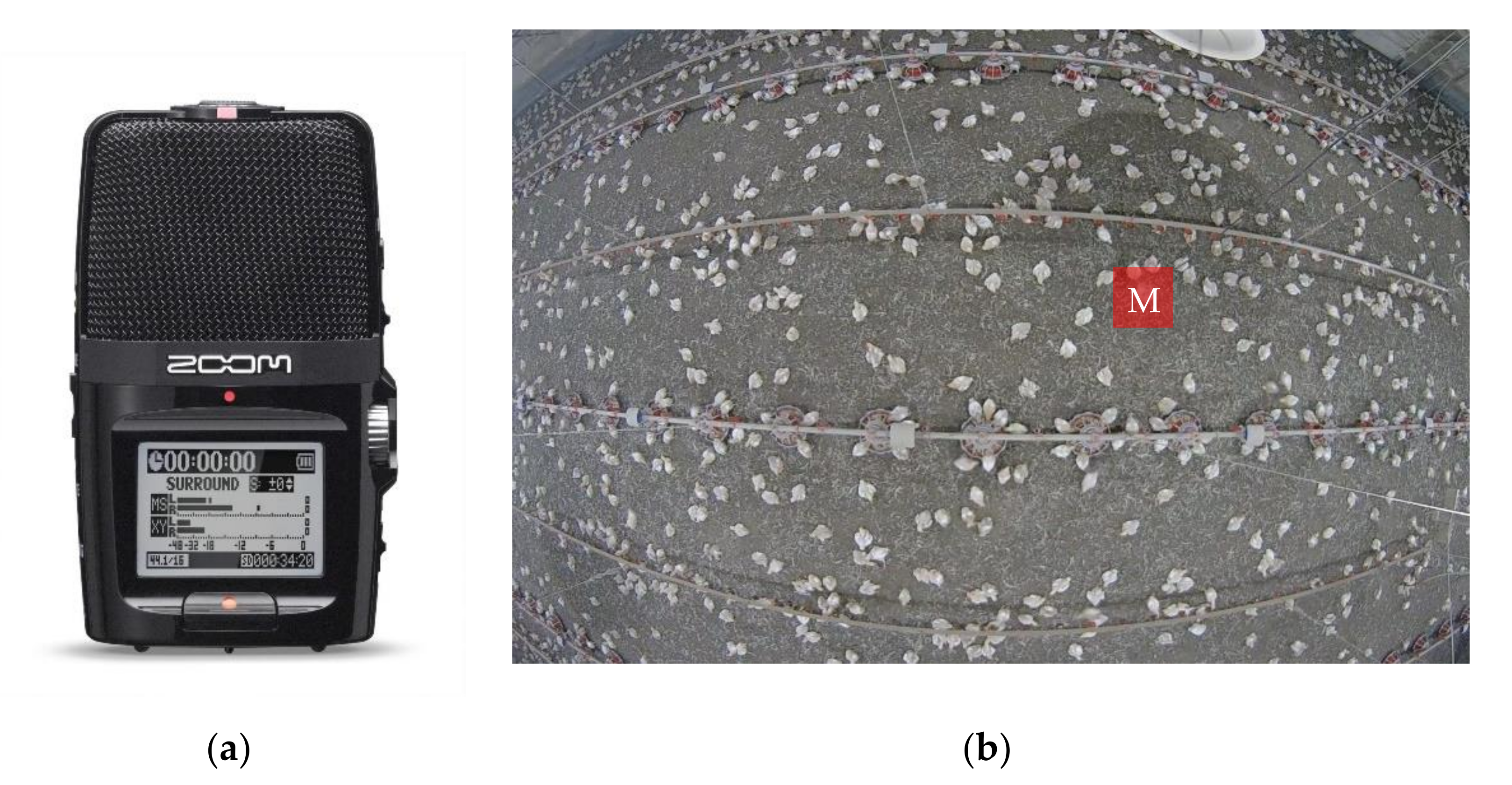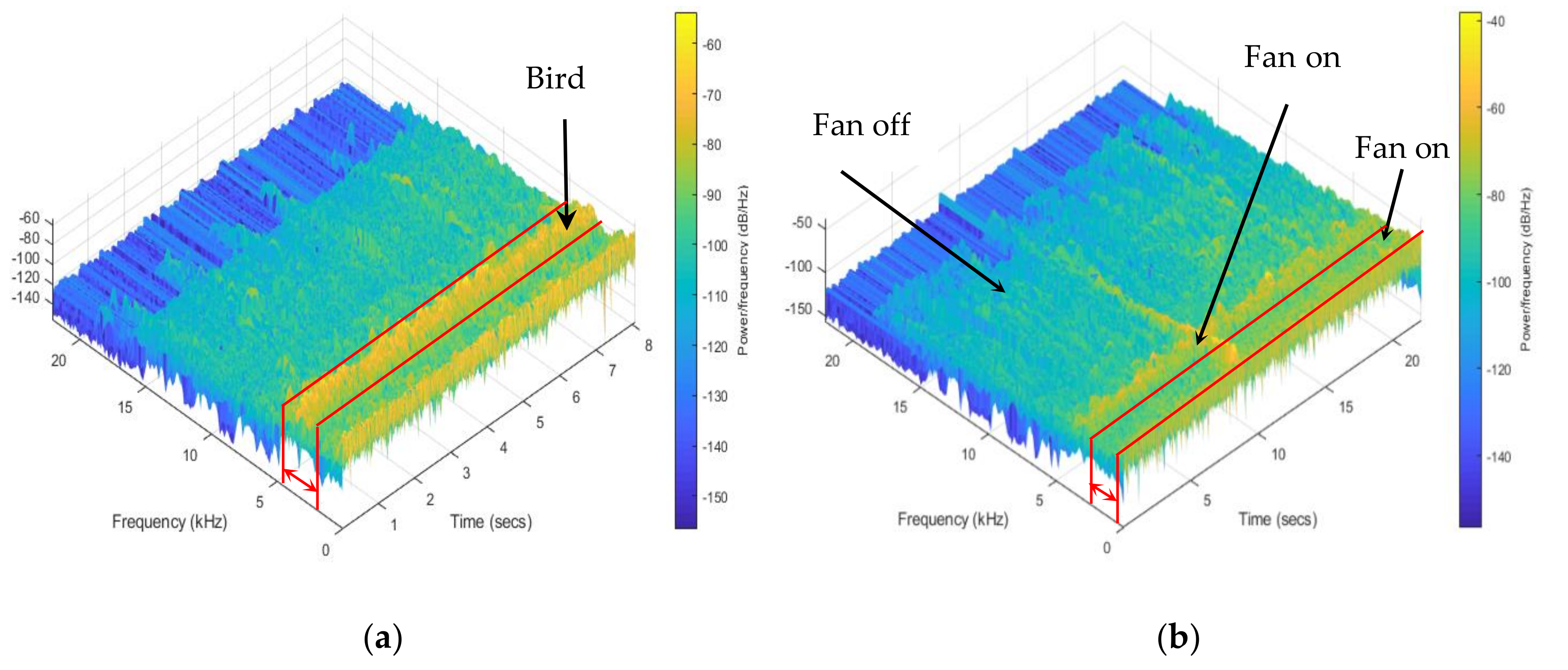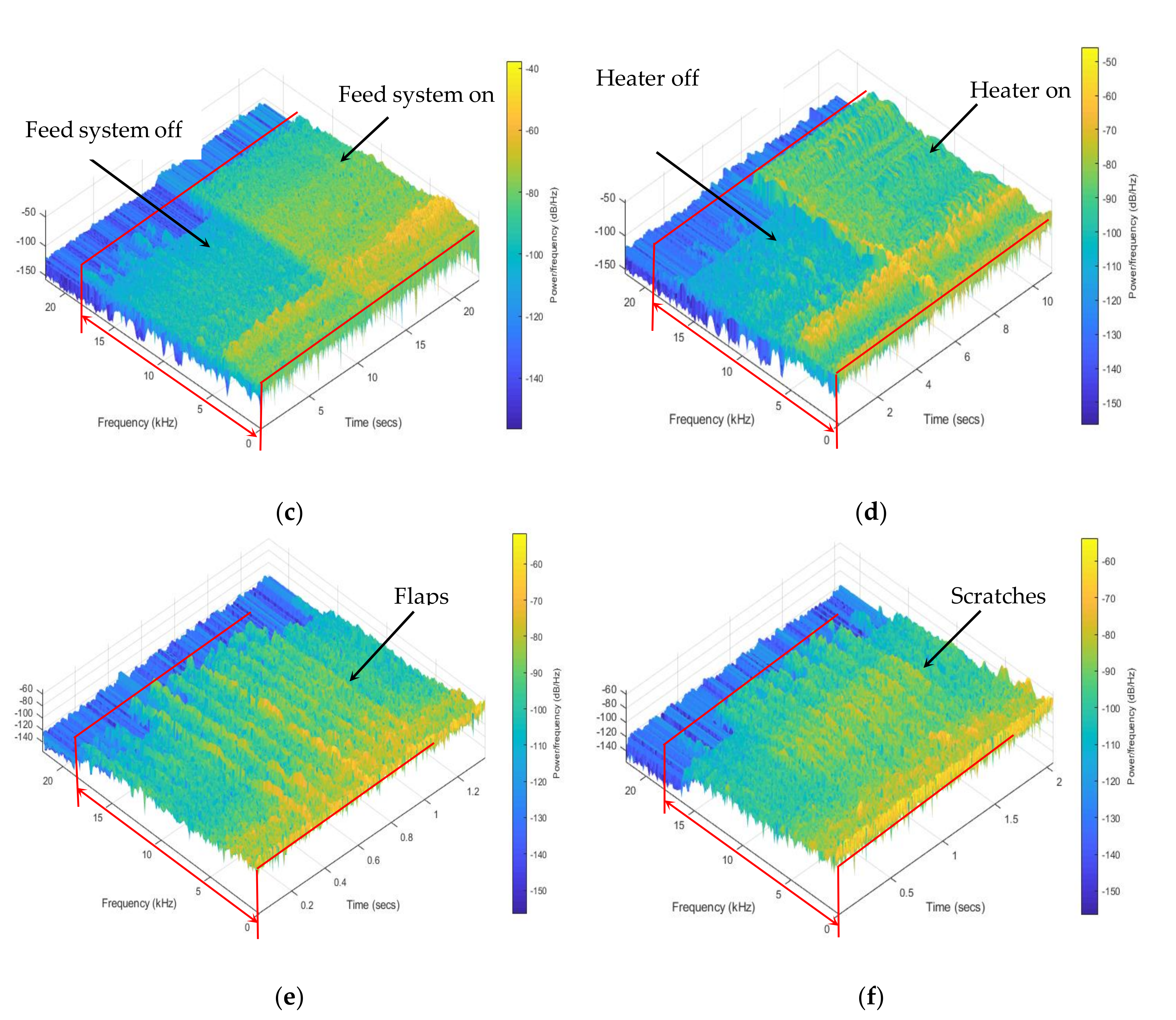Characterizing Sounds of Different Sources in a Commercial Broiler House
Abstract
:Simple Summary
Abstract
1. Introduction
2. Materials and Methods
2.1. Housing, Animals and Management
2.2. Audio Data Collection and Camera System
2.3. Sound Discription
2.4. Audio Signal Labeling and Pre-Processing
2.5. Maximum Overlap Discrete Wavelet Transform (MODWT)
2.6. Signal Processing
2.7. Statistic Analysis
3. Results
3.1. Bird Vocalization
3.2. Fan
3.3. Upper Limits of Feed System, Heater, Wing Flapping and Dustbathing
3.4. Behavioral Frequency
4. Discussion
5. Conclusions
Author Contributions
Funding
Institutional Review Board Statement
Data Availability Statement
Acknowledgments
Conflicts of Interest
References
- Bracewell, R.N. The Fourier Transform and Its Applications; McGraw-Hill: New York, NY, USA, 1986; Volume 31999. [Google Scholar]
- Christiano, L.J.; Fitzgerald, T.J. The band pass filter. Int. Econ. Rev. 2003, 44, 435–465. [Google Scholar] [CrossRef]
- Dörfler, M.; Bammer, R.; Grill, T. Inside the spectrogram: Convolutional Neural Networks in audio processing. In Proceedings of the 2017 International Conference on Sampling Theory and Applications (SampTA), Tallinn, Estonia, 3–7 July 2017. [Google Scholar]
- Deniz, N.N.; Chelotti, J.O.; Galli, J.R.; Planisich, A.M.; Larripa, M.J.; Rufiner, H.L.; Giovanini, L.L. Embedded system for real-time monitoring of foraging behavior of grazing cattle using acoustic signals. Comput. Electron. Agric. 2017, 138, 167–174. [Google Scholar] [CrossRef]
- Sheng, H.; Zhang, S.; Zuo, L.; Duan, G.; Zhang, H.; Okinda, C.; Shen, M.; Chen, K.; Lu, M.; Norton, T. Construction of sheep forage intake estimation models based on sound analysis. Biosyst. Eng. 2020, 192, 144–158. [Google Scholar] [CrossRef]
- Chelotti, J.O.; Vanrell, S.R.; Galli, J.R.; Giovanini, L.L.; Rufiner, H.L. A pattern recognition approach for detecting and classifying jaw movements in grazing cattle. Comput. Electron. Agric. 2018, 145, 83–91. [Google Scholar] [CrossRef]
- Cuan, K.; Zhang, T.; Huang, J.; Fang, C.; Guan, Y. Detection of avian influenza-infected chickens based on a chicken sound convolutional neural network. Comput. Electron. Agric. 2020, 178, 105688. [Google Scholar] [CrossRef]
- Chung, Y.; Oh, S.; Lee, J.; Park, D.; Chang, H.-H.; Kim, S. Automatic Detection and Recognition of Pig Wasting Diseases Using Sound Data in Audio Surveillance Systems. Sensors 2013, 13, 12929–12942. [Google Scholar] [CrossRef] [PubMed] [Green Version]
- Hemeryck, M. The Pig Cough Monitor in the EU-PLF project results and multimodal data analysis in two case studies. In Proceedings of the 7th European Conference on Precision Livestock Farming (EC-PLF), Milan, Italy, 15–18 September 2015. [Google Scholar]
- Aydin, A.; Berckmans, D. Using sound technology to automatically detect the short-term feeding behaviours of broiler chickens. Comput. Electron. Agric. 2016, 121, 25–31. [Google Scholar] [CrossRef]
- Aydin, A.; Bähr, C.; Berckmans, D. A real-time monitoring tool to automatically measure the feed intakes of multiple broiler chickens by sound analysis. Comput. Electron. Agric. 2015, 114, 1–6. [Google Scholar] [CrossRef]
- Fontana, I.; Tullo, E.; Scrase, A.; Butterworth, A. Vocalisation sound pattern identification in young broiler chickens. Animal 2016, 10, 1567–1574. [Google Scholar] [CrossRef] [PubMed] [Green Version]
- Fontana, I.; Tullo, E.; Carpentier, L.; Berckmans, D.; Butterworth, A.; Vranken, E.; Norton, T.; Berckmans, D.; Guarino, M. Sound analysis to model weight of broiler chickens. Poult. Sci. 2017, 96, 3938–3943. [Google Scholar] [CrossRef]
- Otten, W.; Kanitz, E.; Puppe, B.; Tuchscherer, M.; Brüssow, K.; Nürnberg, G.; Stabenow, B. Acute and long term effects of chronic intermittent noise stress on hypothalamic-pituitary-adrenocortical and sympatho-adrenomedullary axis in pigs. Anim. Sci. 2004, 78, 271–283. [Google Scholar] [CrossRef]
- Rabin, L.A. Anthropogenic noise and its effect on animal communication: An interface between comparative psychology and conservation biology. Int. J. Comp. Psychol. 2003, 16, 172–192. [Google Scholar]
- Campo, J.; Gil, M.; Dávila, S. Effects of specific noise and music stimuli on stress and fear levels of laying hens of several breeds. Appl. Anim. Behav. Sci. 2005, 91, 75–84. [Google Scholar] [CrossRef]
- Coenen, A.M.L.; Lankhaar, J.; Lowe, J.C.; McKeegan, D.E.F. Remote monitoring of electroencephalogram, electrocardiogram, and behavior during controlled atmosphere stunning in broilers: Implications for welfare. Poult. Sci. 2009, 88, 10–19. [Google Scholar] [CrossRef] [PubMed]
- Cornetto, T.; Estevez, I. Behavior of the Domestic Fowl in the Presence of Vertical Panels. Poult. Sci. 2001, 80, 1455–1462. [Google Scholar] [CrossRef]
- Nason, G.P.; Von Sachs, R.; Sachs, R.V. Wavelets in time-series analysis. Philos. Trans. R. Soc. A Math. Phys. Eng. Sci. 1999, 357, 2511–2526. [Google Scholar] [CrossRef]
- Percival, D.B.; Walden, A.T. Wavelet Methods for Time Series Analysis; Cambridge University Press: Cambridge, UK, 2000; Volume 4. [Google Scholar]
- Nourani, V.; Alami, M.T.; Aminfar, M.H. A combined neural-wavelet model for prediction of Ligvanchai watershed precipitation. Eng. Appl. Artif. Intell. 2009, 22, 466–472. [Google Scholar] [CrossRef]
- Fontana, I.; Tullo, E.; Butterworth, A.; Guarino, M. An innovative approach to predict the growth in intensive poultry farming. Comput. Electron. Agric. 2015, 119, 178–183. [Google Scholar] [CrossRef] [Green Version]
- Bowling, D.L.; Garcia, M.; Dunn, J.C.; Ruprecht, R.; Stewart, A.; Frommolt, K.-H.; Fitch, W.T. Body size and vocalization in primates and carnivores. Sci. Rep. 2017, 7, 41070. [Google Scholar] [CrossRef]
- Bradbury, J.W.; Vehrencamp, S.L. Principles of Animal Communication; Sinauer Associates: Sunderland, MA, USA, 1998. [Google Scholar]
- Ginovart-Panisello, G.J.; Alsina-Pagès, R.M.; Sanz, I.I.; Monjo, T.P.; Prat, M.C. Acoustic Description of the Soundscape of a Real-Life Intensive Farm and Its Impact on Animal Welfare: A Preliminary Analysis of Farm Sounds and Bird Vocalisations. Sensors 2020, 20, 4732. [Google Scholar] [CrossRef]
- Clapham, W.M.; Fedders, J.M.; Beeman, K.; Neel, J.P. Acoustic monitoring system to quantify ingestive behavior of free-grazing cattle. Comput. Electron. Agric. 2011, 76, 96–104. [Google Scholar] [CrossRef]
- Rau, L.M. Developments on real-time monitoring of grazing cattle feeding behavior using sound. In Proceedings of the 2020 IEEE International Conference on Industrial Technology (ICIT), Buenos Aires, Argentina, 26–28 February 2020. [Google Scholar]
- Chelotti, J.O.; Vanrell, S.R.; Milone, D.H.; Utsumi, S.A.; Galli, J.R.; Rufiner, H.L.; Giovanini, L.L. A real-time algorithm for acoustic monitoring of ingestive behavior of grazing cattle. Comput. Electron. Agric. 2016, 127, 64–75. [Google Scholar] [CrossRef] [Green Version]
- Zhang, T.; Wang, J. Design and Implementation of Cow Chewing Behavior Recognition Based on Sound Sensor. In Data Processing Techniques and Applications for Cyber-Physical Systems (DPTA 2019); Springer: Berlin/Heidelberg, Germany, 2020; pp. 817–822. [Google Scholar]
- Meluzzi, A.; Sirri, F. Welfare of broiler chickens. Ital. J. Anim. Sci. 2009, 8, 161–173. [Google Scholar] [CrossRef] [Green Version]
- Odén, K.; Keeling, L.; Algers, B. Behaviour of laying hens in two types of aviary systems on 25 commercial farms in Sweden. Br. Poult. Sci. 2002, 43, 169–181. [Google Scholar] [CrossRef]






| Sound Type | Total Time Labeled (min) | Total Number of Clips |
|---|---|---|
| Bird vocalization | 40.0 | 240 |
| Fan | 40.0 | 240 |
| Feed system | 40.0 | 240 |
| Heater | 5.0 | 30 |
| Wing flapping | 6.7 | 402 |
| Dustbathing | 4.1 | 246 |
| Bird Age (Week) | Lower Limit (Hz) | Upper Limit (Hz) |
|---|---|---|
| 1 | 2481 ± 191 a | 4409 ± 136 a |
| 2 | 2038 ± 201 b | 4289 ± 89 b |
| 3 | 1889 ± 307 c | 3997 ± 128 c |
| 4 | 1461 ± 187 d | 2744 ± 155 d |
| 5 | 1418 ± 164 d | 2668 ± 114 e |
| 6 | 1190 ± 154 e | 2628 ± 113 e |
| 7 | 1100 ± 148 ef | 2615 ± 118 e |
| 8 | 1058 ± 123 f | 2501 ± 88 f |
| average | 1579 | 3231 |
| Bird Age (Week) | Lower Limit (Hz) | Upper Limit (Hz) |
|---|---|---|
| 1 | 353 ± 62 c | 1069 ± 40 d |
| 2 | 331 ± 38 cd | 1080 ± 46 cd |
| 3 | 312 ± 40 d | 1103 ± 52 c |
| 4 | 335 ± 32 cd | 1101 ± 21 c |
| 5 | 407 ± 81 b | 1161 ± 78 b |
| 6 | 446 ± 28 a | 1191 ± 27 a |
| 7 | 417 ± 34 b | 1203 ± 36 a |
| 8 | 428 ± 44 a | 1200 ± 36 a |
| average | 379 | 1139 |
| Bird Age (Week) | Feed System (Hz) | Heater (Hz) | Wing Flapping (Hz) | Dustbathing (Hz) |
|---|---|---|---|---|
| 1 | 18,694 ± 149 c | 18903 ± 24 | - | - |
| 2 | 18,655 ± 244 c | - | - | - |
| 3 | 18,781 ± 61 b | - | 18,830 ± 27 ab | 18,771 ± 26 b |
| 4 | 18,819 ± 45 ab | - | 18,833 ± 50 a | 18,793 ± 27 a |
| 5 | 18,804 ± 54 ab | - | 18,819± 27 b | 18,791 ± 30 a |
| 6 | 18,813 ± 113 ab | - | 18,832± 34 ab | 18,797 ± 32 a |
| 7 | 18,833 ± 40 ab | - | 18,829 ± 27 ab | - |
| 8 | 18,857 ± 25 a | - | 18,837 ± 28 a | - |
| average | 18,782 | 18,903 | 18,830 | 18,788 |
| Bird Age (Week) | Wing Flapping (Hz) | Dustbathing (Hz) |
|---|---|---|
| 1 | - | - |
| 2 | - | - |
| 3 | 17 ± 4 Aa | 16 ± 2 Aa |
| 4 | 14 ± 3 Ab | 12 ± 1 Bb |
| 5 | 14 ± 3 Ab | 12 ± 2 Bb |
| 6 | 13 ± 2 Ab | 11 ± 1 Bb |
| 7 | 11 ± 2 c | - |
| 8 | 10 ± 1 c | - |
Publisher’s Note: MDPI stays neutral with regard to jurisdictional claims in published maps and institutional affiliations. |
© 2021 by the authors. Licensee MDPI, Basel, Switzerland. This article is an open access article distributed under the terms and conditions of the Creative Commons Attribution (CC BY) license (http://creativecommons.org/licenses/by/4.0/).
Share and Cite
Yang, X.; Zhao, Y.; Qi, H.; Tabler, G.T. Characterizing Sounds of Different Sources in a Commercial Broiler House. Animals 2021, 11, 916. https://doi.org/10.3390/ani11030916
Yang X, Zhao Y, Qi H, Tabler GT. Characterizing Sounds of Different Sources in a Commercial Broiler House. Animals. 2021; 11(3):916. https://doi.org/10.3390/ani11030916
Chicago/Turabian StyleYang, Xiao, Yang Zhao, Hairong Qi, and George T. Tabler. 2021. "Characterizing Sounds of Different Sources in a Commercial Broiler House" Animals 11, no. 3: 916. https://doi.org/10.3390/ani11030916
APA StyleYang, X., Zhao, Y., Qi, H., & Tabler, G. T. (2021). Characterizing Sounds of Different Sources in a Commercial Broiler House. Animals, 11(3), 916. https://doi.org/10.3390/ani11030916







